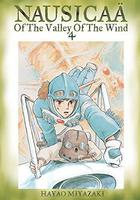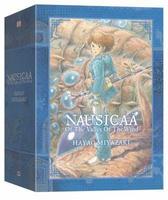Nausicaä of the Valley of the Wind
Nausicaä of the Valley of the Wind (Japanese: 風の谷のナウシカ, Hepburn: Kaze no Tani no Naushika) is a Japanese manga series written and illustrated by Hayao Miyazaki. It tells the story of Nausicaä, a princess of a small kingdom on a post-apocalyptic Earth with a toxic ecosystem, who becomes involved in a war between kingdoms while an environmental disaster threatens humankind. Prior to creating Nausicaä, Miyazaki had worked as an animator for Toei Animation, Nippon Animation and Tokyo Movie Shinsha (TMS), the latter for whom he had directed his feature film debut, Lupin III: The Castle of Cagliostro (1979). After working on an aborted adaptation of Richard Corben's Rowlf for TMS and the publishing firm Tokuma Shoten, he agreed to create a manga series for Tokuma's monthly magazine Animage, initially on the condition that it would not be adapted into a film. The development of Nausicaä was influenced by the Japanese Heian period tale The Lady who Loved Insects, a similarly-named character from Homer's Odyssey and the Minamata Bay mercury pollution. The setting and visual style of the manga was influenced by Mœbius. It was serialized intermittently in Animage from February 1982 to March 1994 and the individual chapters were collected and published by Tokuma Shoten in seven tankōbon volumes. It was serialized with an English translation in North America by Viz Media from 1988 to 1996 as a series of 27 comic book issues and has been published in collected form multiple times. Since its initial serialization, Nausicaä has become a commercial success, particularly in Japan, where the series has more than 17 million copies in circulation. The manga and the 1984 film adaptation, written and directed by Miyazaki following the serialization of the manga's first sixteen chapters, received universal acclaim from critics and scholars for its characters, themes, and art. The manga and film versions of Nausicaä are also credited for the foundation of Studio Ghibli, the animation studio for which Miyazaki created several of his most recognized works. Source: Wikipedia (en)
1. Nausicaä of the Valley of the Wind, Vol. 1
2. Nausicaa of the Valley of the Wind
3. Nausicaä of the Valley of the Wind - 3
4. Nausicaä of the Valley of the Wind - 4
5. Nausicaä of the Valley of the Wind - 5
6. Nausicaä of the Valley of the Wind - 6
7. Nausicaä of the Valley of the Wind - 7
The Art of Nausicaä of the Valley of the Wind: Watercolor Impressions
Series - wd:Q95047








